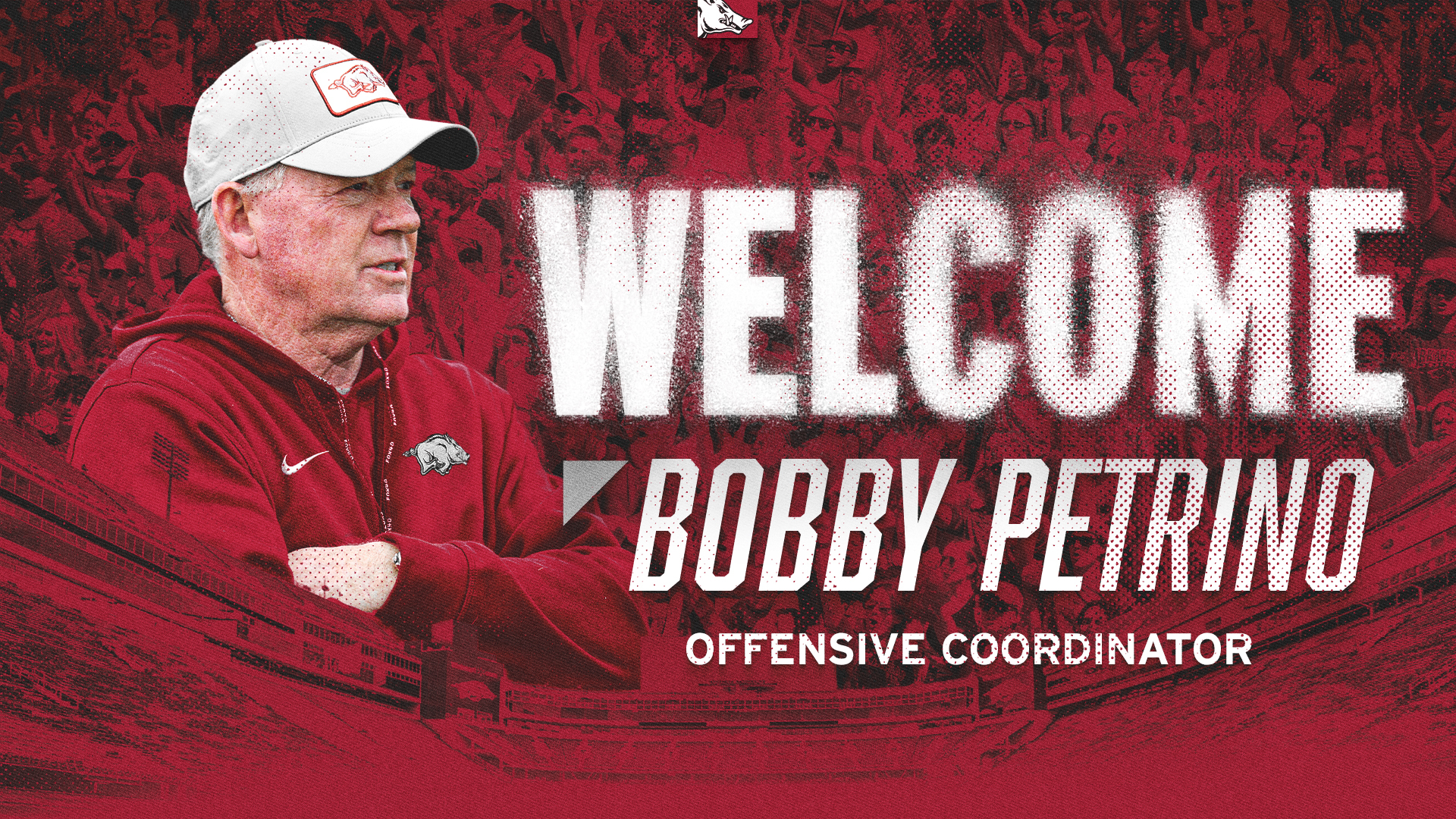The Razorbacks have made their move and… we did not see this one coming.
Just hours after reports began to leak that the Hogs had been turned down by their top options, including UNLV’s Brennan Marion, ESPN’s Pete Thamel reported that the Hogs were “vetting” the hire of Bobby Petrino. Yes, that Bobby Petrino. A deal was apparently reached on Tuesday night and Petrino’s hire was announced by the university on Wednesday.
That “vetting” was probably getting permission from the university president to hire Petrino, whose hire is otherwise forbidden since he was fired for cause, as Best of Arkansas Sports’ Andrew Hutchinson laid out nicely.
In case you’ve been living under a rock, Petrino was Arkansas’ head coach from 2008 to 2011, going 34-17, including 17-15 in the SEC. The Hogs were 21-5 over Petrino’s final two seasons, a stretch which included the program’s lone BCS bowl and a Cotton Bowl win. He was fired in April 2012 after a motorcycle accident led to the revelation that was he was having an affair, had hired his mistress, and had lied to the university about it.
Why would Arkansas do this? I think the answer is obvious: in the 12 seasons since Petrino’s firing, Arkansas has had one winning SEC record. Petrino won six SEC games twice; the Hogs have not done that since. Arkansas couldn’t win without him, and now the opportunity has arrived to win with him. As you can imagine, the hire was greeted with jubilation from most of the Razorback faithful. In an excellent article on ESPN, Petrino makes it quite clear: he wants to right the wrong he caused the university back in 2012.
I also think it has to be pointed out that this took incredible humility from Sam Pittman to allow this. He’s been the very popular face of Razorback football for four years, and he just invited back the only coach in the last decade-plus that was more successful than him. If the offense turns it around, Petrino will get all the credit, but if the turnaround doesn’t happen, Pittman will be fired. There is almost no personal glory for him in this. He just wants to win that badly and is now acutely aware of his own limitations. If this somehow goes well, make sure he gets proper credit, and if it doesn’t, don’t blame him for trying his best.
So this is setting up to be an incredible redemption story. But will it happen?
No hard feelings, no bad vibes
Among Arkansas fans and former players, the overwhelming majority is in favor of this hire. Hog fans remember that Petrino delivered Arkansas’ two best seasons since the Hogs joined the SEC in 1992 and did it while the SEC West was at the height of its power.
But from Arkansas’ standpoint, let’s be clear: this is a desperation hire. Some Hail Marys are caught, but this is a Hail Mary by Sam Pittman, who really wants to save his job. Petrino hasn’t actually had a great offense since Lamar Jackson’s final year in 2017. The national perception is that he’s a toxic individual and he’s lost his fastball. But if top options like Marion did in fact say no, Pittman probably realized that the sour mood around the program right now would never allow him to introduce an underwhelming OC hire without season ticket sales and recruiting absolutely collapsing like a stock market reacting to horrible news. So Petrino was the only viable option to salvage momentum.
This momentum play seems to have worked, at least so far, given the excitement on social media and message boards and t-shirts and chants at Wednesday’s basketball game. But while Hog fans are imagining the story of Petrino’s return as a 30 for 30 waiting to happen, national media is imagining it (as SI’s Pat Forde put it in a podcast) more like a season of Yellowstone, a high-stakes drama where Petrino is a cutthroat character prepared to stab anyone in the back to gain power. USA Today’s Dan Wolken asked his followers to give him “the date when Bobby Petrino gets named interim head coach next year because we all know that’s happening.”
Is this actually a good idea?
Is Petrino still a good coach? And is this going to work or crash and burn? It’s hard to judge, given all the factors involved, but let’s look at Petrino since leaving Fayetteville.
In 2013, he went 8-5 in one season with Western Kentucky before jumping to Louisville to replace Charlie Strong, who went to Texas. Over his first four seasons, he was a respectable 34-18, going exactly 8-5 or 9-4 in each season. But the last two of those years, he had Lamar Jackson, and porous defense and a subpar offensive line meant he could never quite take advantage of having the most dynamic player in college football. After Jackson left, the Cardinals tanked to 2-10 and Petrino was fired, with defense and offensive line being the main culprits of his downfall, though the firing of his boss Tom Jurich in 2017 over Louisville’s basketball scandal didn’t really help. His inability to hire good coordinators due to his toxic reputation played a pretty significant role as well.
After taking a year off, he resurfaced at Missouri State, where he went 18-15 in three seasons with the Bears, reaching a pair of FCS playoffs. That’s pretty impressive work, given that Missouri State is historically a cellar-dwellar in the FCS. By this time, he had relatives in both coordinator positions, as no one else really wanted to work for him.
Realizing his time as a head coach was over, he accepted the UNLV OC job under Barry Odom before jumping ship and going to College Station instead. In 2023, the Aggies finished 35th in predicted points per drive and 49th in opponent-adjusted EPA per play. For the talent level, that’s a mild disappointment, even if star QB Conner Weigman did miss most of the season with an injury after a hot start. But for context, both of those numbers were about 20-25 spots better than they had been the year before, when Jimbo Fisher was running the offense himself. And it might be fair to question exactly how much of the Aggie offense was Petrino’s, given comments Petrino has made since his hiring about how much influence Jimbo maintained.
My analysis: this might work, and it might not. Shocking, I know. But I was an early skeptic of the Dan Enos hire, and I like this hire more, largely because the potential for it work really well is there. I also recognize that there’s a pretty good chance this thing blows up pretty badly. Again, there are excuses and confounding variables, but Petrino hasn’t had an elite offense in a while. And Petrino rarely leaves a job on good terms. And he’s schemed to steal a job from his head coach before (Auburn, 2003). But it’s probably worth noting that unlike his backstabbing of Louisville (the first time), Auburn, the Jaguars, the Falcons, and UNLV, he never intentionally betrayed the University of Arkansas and has said nothing but nice things both during his first stint and ever since. And reports from both Missouri State and Texas A&M have said that he’s mellowed significantly, is much easier to work with and for, and does not mistreat his players and support staff nearly as badly as he did in years past.
At some point, his career will end, and I imagine he wants that to be on a good note. Are we all suckers for believing that could be in Fayetteville?
What to expect from the Petrino offense
The hype will fade, and now, the work begins. Arkansas has to at least make a bowl next year to keep the Pittman era alive. If Petrino’s redemption story is going to come true, he’s got a major job ahead of him.
Offensively, don’t expect Petrino’s offense to look exactly like it did during his first stint. The reason is that college football evolves, and while nostalgia may sell tickets, it doesn’t win games. The offense Petrino has run since leaving Fayetteville the first time is still the same basic scheme, but it reflects a continuing evolution of his philosophy in response to modern defenses.
The Oneback
Schematically, Petrino’s background is in the old Oneback offense made famous by practitioners such as Mike Price (who led Washington State and QB Ryan Leaf to the Rose Bowl), Dennis Erickson (who won the 1989 and 1991 national titles at Miami), and Joe Tiller (who coached Drew Brees at Purdue). It is the original “spread” offense, and most modern spread-type schemes are descended from it. Hal Mumme (creator of the Air Raid) and Urban Meyer both studied the early Oneback when designing their own offense.
The original Price-Erickson Oneback used, as the name implies, just one running back and three or four wide receivers. The wide splits combined with vertical-stemmed routes forced the defense to defend horizontally and vertically. The wide formations made it hard to stack the box against the run, and the frequent use of “option” routes by slot receivers made it difficult for linebackers to cheat into the box without losing leverage on their receiver.

Petrino had his breakthrough into Division I coaching as a GA for Price at Weber State in 1984 and as an assistant in 1987. When Erickson’s former defensive coordinator John L. Smith got the Idaho head coaching job in 1989, he wanted to run the Oneback and hired Petrino to do so as his offensive coordinator. Throughout the 1990s and 2000s, Petrino was a faithful disciple of the Oneback. But in the early 2000s, as defenses began to adjust and old Oneback gurus such as Price, Erickson, and Tiller lost their advantage, Petrino continued to evolve, borrowing from other spread innovators, namely Steve Spurrier. A brief stint as an NFL assistant helped him make his offense more “pro-style”. By the time he was hired as Arkansas’ coach in 2008, he had taken to calling his offense a “power spread”: spread by philosophy, but willing to run power against any defense not willing to commit to defending the run.
Petrino’s innovations
To introduce the Petrino scheme, let’s pick the single play he’s most famous for: Shark.

Or, if you’re like me and learned about the Petrino offense by playing NCAA Football 14, then maybe this will be familiar:

There are actually three different two-route concepts happening here. Let’s look at them:
- Shallow Cross. That’s the underneath crossing route by the slot receiver. The tight end’s deeper square-in should pull back the linebackers so the shallow crosser will be open underneath. This is a common Price/Erickson Oneback concept, and an underneath shallow crossing route is a feature of almost every dropback pass in Petrino’s playbook.
- Mills. That’s the post over the square-in. This is a classic Spurrier design. The square-in from the tight end, in addition to working the Shallow Cross, also pulls down the safety in some coverages, which would leave the post wide open for a home run play. The first FBS touchdown of the 2013 season was scored by Spurrier’s South Carolina on a Mills play where the safety jumped the underneath route.
- Post/Wheel. This is adapted from the old Spurrier “slot wheel” concept that acts as a Cover 3 beater: the post route moves the safety over so the wheel is wide open. Petrino ran slot wheels on occasion, but found more success having his running back run the wheel out of the backfield.
Petrino designed several variations of this play, but the basic concepts are the same. This is the play that Ryan Mallett diagrammed for Jon Gruden on Gruden’s QB Camp ahead of the 2011 draft.
On the second play from scrimmage against Alabama in 2010, Petrino dialed this play up for one of the best-known touchdowns of his time in Fayetteville:
Shark – “Post/Wheel”
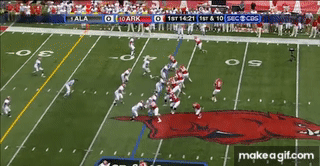
With six seconds left in the first half against LSU later that season, what’s Petrino calling? You guessed it:
Shark – “Mills”
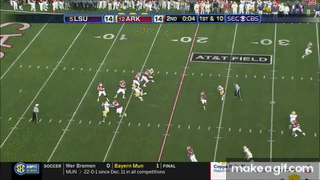
As mentioned above, a large portion of Arkansas’ offense was just a few basic concepts dressed up to look a little different. Here’s the shallow cross concept from the diagram above, but now the square-in and crosser are coming from the same side. This concept is called “drive” but it is functionally the same as “shallow cross”:
Shark – “Drive” (Trips)
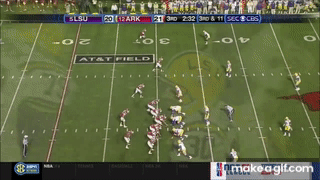
Note the running back taking off on the wheel route at the bottom of the gif.
All of these are actually just variations of the same play. You see aggressive downfield routes and throws down the field to back the defense up, with the main goal being to get fast receivers in space. That’s the spread offense in a nutshell.
Here’s a more recent shallow cross:
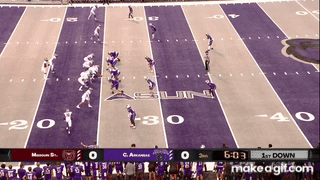
And a more recent running back wheel route:
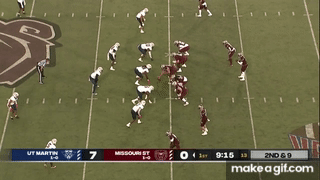
So the basics of Petrino’s offense haven’t changed, but his offense has continued to change with the times. Petrino was almost-certainly intrigued by the innovation of spread-to-run offenses introduced in waves in the 2000s by Rich Rodriguez, Gus Malzahn, and Urban Meyer. The Oneback had spread defenses out in order to create passing lanes, but now great offensive minds were spreading defenses out in order to run the ball.
In 2011, Petrino started his tinkering with a read-option package for backup QB Brandon Mitchell. Petrino might have been planning for Mitchell to be Arkansas’ starter in 2013. Instead, Petrino had to wait to apply those ideas until he got to Louisville in 2014 and recruited a quarterback named Lamar Jackson. With Jackson at QB, Petrino transitioned his entire run game to be read-based, allowing the quarterback the option to keep the ball if the backside of the defense loses contain.
Since Jackson left for the NFL, Petrino has mostly stuck with dual-threat quarterbacks who present a run threat. These read runs – especially outside zone read, which Arkansas ran a ton of under Kendal Briles – fit in with the basic philosophy of the Oneback: spread horizontally in order to attack vertically.
Compared to what saw from Enos, the changes should be significant. Expect wider formations, fewer screens, a heavier reliance on zone run schemes, and much more downfield passing especially to receivers in space. Pass protection (or lack thereof) is a serious threat to the Petrino offense; it played a role in Texas A&M’s struggles, though that was an issue before Petrino got there. That means Arkansas will have to significantly improve its ability to protect its quarterback, whoever that is.
Staff and roster changes
Pittman has already said he expects some other staff changes, and that probably means Cody Kennedy is first on the chopping block. The Hogs simply have to protect better for Petrino’s offense to work, so the Hogs are going to need a better coach and a bunch of transfers. I would also expect some current linemen to transfer out to make room, though holding onto high-upside guys like Patrick Kutas and Andrew Chamblee will be important (totally rebuilding a line in the portal is really hard).
A lot of talk surrounds KJ Jefferson: is he a fit for this offense? Jefferson is certainly not the type of quarterback that Petrino would recruit, but that doesn’t mean he can’t use him. Jefferson has actually been fairly accurate on downfield throws throughout his career, though he never really developed enough as a passer to make the complicated reads the Petrino offense requires.
If not Jefferson, Jacolby Criswell is a more natural fit as a pass-first dual-threat quarterback, but I think Pittman and Petrino will look at the portal to see if there’s interest from a big fish, like Oregon State transfer DJ Uiagaleilei. If Jefferson does leave, I think Arkansas will bring in a transfer regardless, if only to push Criswell and offer depth.
Receiver is another position that requires an upgrade, and this one might be make-or-break given the need for the offense to generate explosives through the air. Petrino’s first stint was all about awesome receivers, but Arkansas’ 2023 receiving corps was probably the weakest in the SEC except for Vanderbilt. Getting separation was a major issue, and the few receivers who could get open had issues with drops, and Arkansas ranked at the bottom of the conference in yards after catch despite calling a lot of screens. Petrino’s offense needs speedy receivers with some wiggle, who can both get open and get extra yards after the catch. Incoming 4-star recruit Ashton Bethel-Roman could be an instant-impact player, and the Hogs would love to get Pine Bluff 4-star Courtney Crutchfield back in the fold. Beyond that, Arkansas is going to need at least one high-impact transfer. Without a major talent upgrade, the Hogs will have to be dink-and-dunk on offense, which will make it hard to win.
The main positions that are probably fine are tight end and running back. Luke Hasz has already said he’s coming back, which is a good start. The Hogs really need to hold onto Isaiah Augustave, who played really well over the final two games. Rumors are flying that Rocket Sanders is out, but Augustave plus a veteran like Rashod Dubinion or AJ Green would still make for a strong backfield.
Setting the expectation
The sour mood over the decision to retain Pittman seems to be completely gone from the Razorback faithful. In that sense, the hire was a success from a program momentum standpoint. But it’s all for naught if Arkansas goes 5-7 or worse next year, because missing a bowl almost-certainly means the end of the Pittman era. I think 7-5 is the minimum record to keep Pittman safe, which is doable given the manageable schedule.
Two September games against Oklahoma State and Texas A&M – neither at home – will be telling. The Hogs might can lose both and be okay, but I think we need to see at least a split to feel good heading into October.
Thanks for reading! Be sure to follow us on Twitter and on Facebook.
The latest from Fayette Villains, straight to your inbox
Enter your email to subscribe and receive new post alerts and other updates. You can unsubscribe at any time.
